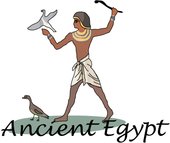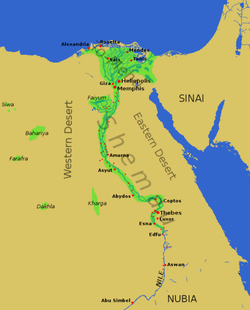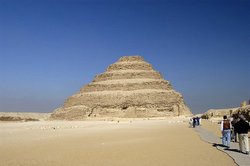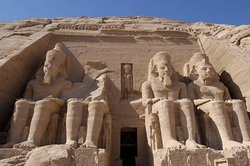Ancient Egypt
|
|
| Contents |
Geography
Most of the geography of Egypt is in North Africa; the Sinai Peninsula is in Southwest Asia. The country has shorelines on the Mediterranean Sea and the Red Sea; it borders Libya to the west, Sudan to the south, and the Gaza Strip, Palestine and Israel to the east. The Nile has been the lifeline for Egyptian culture since the Stone Age.
Ancient Egypt was divided into two kingdoms, known as the Upper and Lower Egypt. Nomes were the subnational administrative divisions. The Pharaohs were known as the rulers of the Two Kingdoms, viz. upper and lower Egypt.
It is unknown where the land of Punt was and why it was referred to as "God's Land." The exact location of Yam is disputed. And it is unknown if Alashiya was actually the island of Cyprus.
Ancient Achievements
The art and science of engineering was present in Egypt, such as accurately determining the position of points and the distances between them (known as surveying). These skills were used to outline pyramid bases. The Egyptian pyramids took the geometric shape formed from a polygonal base and a point, called the apex, by triangular faces. Hydraulic Cement was first invented by the Egyptians. The Al Fayyum Irrigation (water works) was one of the main agricultural breadbaskets of the ancient world. There is evidence of ancient Egyptian pharaohs of the twelfth dynasty using the natural lake of the Fayyum as a reservoir to store surpluses of water for use during the dry seasons. From the time of the First dynasty or before, the Egyptians mined turquoise in Sinai Peninsula.
The earliest evidence (circa 1600 BC) of traditional empiricism is credited to Egypt, as evidenced by the Edwin Smith and Ebers papyri. The roots of the Scientific method may be traced back to the ancient Egyptians. The ancient Egyptians are also credited with devising the world's earliest known alphabet, decimal system [1] (http://www.math.buffalo.edu/mad/Ancient-Africa/mad_ancient_egyptpapyrus.html#berlin) and complex mathematical formularizations, in the form of the Moscow and Rhind Mathematical Papyri. An awareness of the Golden ratio seems to be reflected in many constructions, such as the Egyptian pyramids.
Timeline of Ancient Achievements
- 4000 BCE - Iron Age & Mortar (masonry)
- 3500 BCE - Faience
- 3100 BCE - world's earliest known decimal system [2] (http://www.math.buffalo.edu/mad/Ancient-Africa/mad_ancient_egyptpapyrus.html#berlin)
- 3000 BCE - Medical Institutions
- 3000 BCE - Papyrus, world's earliest known paper
- 2900 BCE - Senet, world's oldest confirmed board game
- 2700 BCE - world's earliest known Surgery
- 2700 BCE - precision Surveying
- 2600 BCE - Sphinx, still today the world's largest single-stone statue
- 2600 BCE - Barge transportation, stone blocks (see Egyptian pyramids: Construction)
- 2600 BCE - Pyramid of Djoser, world's earliest known large-scale stone building
- 2600 BCE - Menkaure's Pyramid & Red Pyramid, world's earliest known works of carved granite
- 2600 BCE - Red Pyramid, world's earliest known "true" smooth-sided pyramid; solid granite work
- 2580 BCE - Great Pyramid of Giza, the world's tallest structure until 1300 CE
- 2500 BCE - world's earliest known direct evidence for Shipbuilding (see Pharaoh Sahure: History, [3] (http://www.msichicago.org/exhibit/ships/), [4] (http://www.touregypt.net/featurestories/navy.htm))
- 2400 BCE - Astronomical Calendar, used even in the Middle Ages for its mathematical regularity
- 1860 BCE - possible Nile-Red Sea Canal (Twelfth dynasty of Egypt)
- 1800 BCE - world's oldest known alphabet
- 1800 BCE - Berlin Mathematical Papyrus, [5] (http://www.math.buffalo.edu/mad/Ancient-Africa/mad_ancient_egyptpapyrus.html#berlin), 2nd order algebraic equations
- 1800 BCE - Moscow Mathematical Papyrus, generalized formula for volume of frustrum
- 1650 BCE - Rhind Mathematical Papyrus: geometry, cotangent analogue, algebraic equations, arithmetic series, geometric series
- 1600 BCE - Edwin Smith papyrus, medical tradition traces as far back as c. 3000 BC
- 1550 BCE - Ebers Medical Papyrus, traditional empiricism
- 1500 BCE - world's earliest documented glass-making
- 1300 BCE - Brugsch Papyrus
- Other:
- c.1800 BCE - Ipuwer papyrus
- c.1800 BCE - Papyrus Harris I
- Unknown date - Rollin Papyrus
- c.1400 BCE - Tulli Papyrus
- c.2500 BCE - Westcar Papyrus
Open problems
Some have purported that modern calculations reveal the Great Pyramid of Giza impossible to construct in a reasonable time frame (see Great Pyramid of Giza: Labor and Moscow Papyrus) without the aid of a sort of ancient Egyptian crane. A carved stone relief [6] (http://www.bib-arch.org/bswb_AO/bswbao0804ancient.html) from the first or second century found in the tomb of the Haterii family in Rome shows a crane being used to build a monument.
There is a question as to the sophistication of ancient Egyptian technology, and there are several open problems concerning real and alleged ancient Egyptian achievements. Certain artifacts and records do not fit with conventional technological development systems. It is not known why there is no neat progression to an Egyptian Iron Age nor why the historical record shows the Egyptians taking so long to begin using iron. It is unknown how the Egyptians shaped and worked granite. The exact date the Egyptians started producing glass is debated.
Some question whether the Egyptians were capable of long distance navigation in their boats and when they become knowledgeable seamen. It is contentiously disputed as to whether or not the Egyptians had some understanding of electricity and if the Egyptians used engines or batteries. The relief at Dendera is interpertered in various ways by scholars. The topic of the Saqqara Bird is controversial, as is the extent of the Egyptians' understanding of aerodynamics. It is unknown for certain if the Egyptians had kites or gliders.
Language
Language records of the Ancient Egyptian language have been dated to about 3000 BC. Most people refer to Egyptian hieroglyphs when they speak about Egyptian writing. It is uncertain if Egyptians were the first to invent writing and written language, via the Egyptian hieroglyph. It is debated as to why the Egyptians used hieroglyphs.
It is a common misconception that the hieroglyphs are pictures that represent ideas instead of the sounds of the language. While the shapes of the hieroglyphs are indeed taken from real (or imaginary) objects, most of them are used for their phonetic value. Hieratic is a cursive form of Egyptian hieroglyphs first used during the 1st Dynasty (c. 2925 BC - c. 2775 BC). Demotic referes to both the ancient Egyptian script which followed hieratic and is the late stage of the Egyptian language that the Demotic script was used to write.
The oldest known alphabet was created in ancient Egypt.
Literature:
- Story of Sinuhe - Sinuhe, a deserter or hero
- Story of Wenamun
Literary:
History
The history of Ancient Egypt started when Egypt was a unified state, sometime around 3300 BC. It survived as an independent state until about 1300 BC. Archaeological evidence indicates that a developed Egyptian society may have existed for much longer though. Along the Nile in the 10th millennium BC a grain-grinding culture using the earliest type of sickle blades had become replaced by another culture of hunters, fishers and gathering peoples using stone tools (see 10th millennium BC). Evidence also indicates human habitation in the southwestern corner of Egypt, near the Sudan border, before 8000 BC. Climate changes and/or overgrazing around 8000 BC began to desiccate the pastoral lands of Egypt, eventually forming the Sahara (c.2500 BC), and early tribes naturally migrated to the Nile river where they developed a settled agricultural economy and more centralized society (see Nile: History). There is evidence of pastoralism and cultivation of cereals in the East Sahara in the 7th millennium BC (see 7th millennium BC). By 6000 BC ancient Egyptians in the southwestern corner of Egypt were herding cattle and constructing large buildings. Mortar (masonry) was in use by 4000 BC.
Egyptian chronology involves assigning beginnings and endings to various Dynasties. The conventional Egyptian chronology is the accepted developments during the 20th century but not including any of the major revision proposals that have also been made in that time. Even within a single work, often archeologists will offer several possible dates or even several whole chronologies as possibilities. Consequently, there may be discrepancies between dates shown here and in articles on particular rulers. Often there are also several possible spellings of the names.
- List of Pharaohs -- The Pharaohs stretch from before 3000 BC through to around 30 BC.
- Dynasties
- Early Dynastic Period of Egypt (1st to 2nd dynasties; until ca. 27th century BCE)
- Old Kingdom (3rd to 6th dynasties; 27th to 22nd centuries BCE)
- First Intermediate Period (7th to 11th dynasties)
- Middle Kingdom of Egypt (11th to 14th dynasties; 20th to 17th centuries BCE)
- Second Intermediate Period (14th to 17th dynasties)
- Hyksos (15th to 16th dynasties)
- New Kingdom of Egypt (18th to 20th dynasties; 16th to 11th centuries BCE)
- Third Intermediate Period (21st to 25th dynasties; 11th to 7th centuries BCE)
- Late Period of Ancient Egypt (26th to 31 dynasties; 7th century BC to 332 BCE)
- Graeco-Roman Egypt (332 BCE to 639 CE)
Culture
The Egyptian religions, emboddied in Egyptian mythology, were a the succession of beliefs held by the people of Egypt until the coming of Christianity and Islam. This was conducted by Egyptian priests or magicians, but the use of magic and spells is questioned. The religious nature of Ancient Egyptian civilization influenced it's contribution to the arts of the ancient world. Many of the great works of Ancient Egypt depict gods, goddesses, and Pharaohs, who were also considered divine. Ancient Egyptian art in general is characterized by the idea of order.
Evidence of mummies and pyramids outside Ancient Egypt indicate reflections of ancient Egyptian belief values on other prehistoric cultures, transmitted in one way over the Silk Road.
Some scholars have speculated that Egypt's art pieces are sexually symbolic.
See also
Ancient Egyptian Peoples
Originally, much of North Africa was inhabited by black Africans, including Upper Egypt, as demonstrated by Saharan rock art throughout the region; however, this does not appear to have been the case in the Maghreb and Lower Egypt, which seem to have been continuously inhabited by Caucasoid peoples speaking Afro-Asiatic languages. Following the desiccation of the Sahara, most black Africans migrated South into East and West Africa. The Aterian culture that developed here was one of the most advanced paleolithic societies. In the mesolithic the Capsian culture dominated the region with neolithic farmers becoming predominant by 6000 BC.
A recent genetic study links the maternal lineage of a traditional population from Upper Egypt to Eastern Africa [7] (http://www.ncbi.nlm.nih.gov/entrez/query.fcgi?cmd=Retrieve&db=pubmed&dopt=Abstract&list_uids=14748828). A separate study further narrows the genetic lineage to Northeast Africa ([8] (http://www.ncbi.nlm.nih.gov/entrez/query.fcgi?cmd=Retrieve&db=pubmed&dopt=Abstract&list_uids=12495079); reveals also that modern day Egyptians "reflect a mixture of European, Middle Eastern, and African"). Nilotic peoples are generally very dark-skinned blacks and Caucasoids and today are found primarily in Sudan, Somalia, Kenya, Uganda, Egypt, Ethiopia and Eritrea. Many members of these groups have a taller and slimmer stature than the human average. However the validity of human races is a subject of much debate.
See also
- Egyptology
- Egyptian Museum
- List of Ancient Egyptians
- List of Ancient Egyptian sites
- List of ancient Egypt mysteries
Ancient Egypt Clipart and Pictures
- Ancient Egypt Architecture (http://classroomclipart.com/cgi-bin/kids/imageFolio.cgi?direct=History/Ancient_Civilizations/Ancient_Egypt/Architecture)
- Ancient Egypt Art (http://classroomclipart.com/cgi-bin/kids/imageFolio.cgi?direct=History/Ancient_Civilizations/Ancient_Egypt/Art)
- Ancient Egypt Clipart (http://classroomclipart.com/cgi-bin/kids/imageFolio.cgi?direct=History/Ancient_Civilizations/Ancient_Egypt/Clipart)
- Ancient Egypt Clothing (http://classroomclipart.com/cgi-bin/kids/imageFolio.cgi?direct=History/Ancient_Civilizations/Ancient_Egypt/Clothing)
- Ancient Egypt Architecture (http://classroomclipart.com/cgi-bin/kids/imageFolio.cgi?direct=History/Ancient_Civilizations/Ancient_Egypt/Commerce)
- Ancient Egypt Daily Life (http://classroomclipart.com/cgi-bin/kids/imageFolio.cgi?direct=History/Ancient_Civilizations/Ancient_Egypt/Daily_Life)
- Ancient Egypt Games and Toys (http://classroomclipart.com/cgi-bin/kids/imageFolio.cgi?direct=History/Ancient_Civilizations/Ancient_Egypt/Games_and_Toys)
- Ancient Egypt Hieroglyphs (http://classroomclipart.com/cgi-bin/kids/imageFolio.cgi?direct=History/Ancient_Civilizations/Ancient_Egypt/Hieroglyphs)
- Ancient Egypt People (http://classroomclipart.com/cgi-bin/kids/imageFolio.cgi?direct=History/Ancient_Civilizations/Ancient_Egypt/Historical_People)
- Ancient Egypt Illustrations (http://classroomclipart.com/cgi-bin/kids/imageFolio.cgi?direct=History/Ancient_Civilizations/Ancient_Egypt/Illustrations)
- Ancient Egypt Mummies (http://classroomclipart.com/cgi-bin/kids/imageFolio.cgi?direct=History/Ancient_Civilizations/Ancient_Egypt/Mummies)
- Ancient Egypt Musical Instruments (http://classroomclipart.com/cgi-bin/kids/imageFolio.cgi?direct=History/Ancient_Civilizations/Ancient_Egypt/Musical_Instruments)
- Ancient Egypt Pyramids (http://classroomclipart.com/cgi-bin/kids/imageFolio.cgi?direct=History/Ancient_Civilizations/Ancient_Egypt/Pyramids)
- Ancient Egypt Religion (http://classroomclipart.com/cgi-bin/kids/imageFolio.cgi?direct=History/Ancient_Civilizations/Ancient_Egypt/Religion)
- Ancient Egypt Statues (http://classroomclipart.com/cgi-bin/kids/imageFolio.cgi?direct=History/Ancient_Civilizations/Ancient_Egypt/Statues)
- Ancient Egypt Temples (http://classroomclipart.com/cgi-bin/kids/imageFolio.cgi?direct=History/Ancient_Civilizations/Ancient_Egypt/Temples)
- Ancient Egypt Transportation (http://classroomclipart.com/cgi-bin/kids/imageFolio.cgi?direct=History/Ancient_Civilizations/Ancient_Egypt/Transportation)
- Ancient War and Armies (http://classroomclipart.com/cgi-bin/kids/imageFolio.cgi?direct=History/Ancient_Civilizations/Ancient_Egypt/War_and_Armies)
Lesson Plans, Resources and Activites
- Lesson Plan Central: Ancient Egypt Lesson Plans (http://lessonplancentral.com/lessons/Social_Studies/Ancient_Egypt/index.htm)
- Ancient Egypt Lesson Plans for Teachers (http://www.dia.org/education/egypt-teachers/art/index.htm)
- Egypt Fun Guide (http://www.seaworld.org/fun-zone/fun-guides/egypt/secrets-of-the-nile.htm)
- Egyptomania Coloring Book (http://www.clevelandart.org/kids/egypt/color/index.html)
- Egypt Quiz (http://www.clevelandart.org/kids/egypt/quiz.html)
- Build a Pharaoh (http://www.clevelandart.org/kids/egypt/mask/rose3d.html)






